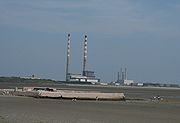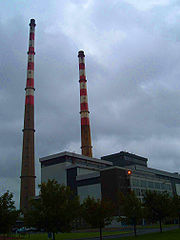
Poolbeg
Encyclopedia

Irish language
Irish , also known as Irish Gaelic, is a Goidelic language of the Indo-European language family, originating in Ireland and historically spoken by the Irish people. Irish is now spoken as a first language by a minority of Irish people, as well as being a second language of a larger proportion of...
: Cumhachtstáisiún an Phoill Bhig) is a power station owned and operated by the Electricity Supply Board
Electricity Supply Board
The Electricity Supply Board , is a semi-state electricity company in Ireland. While historically a monopoly, the ESB now operates as a commercial semi-state concern in a liberalised and competitive market...
of the Republic of Ireland
Republic of Ireland
Ireland , described as the Republic of Ireland , is a sovereign state in Europe occupying approximately five-sixths of the island of the same name. Its capital is Dublin. Ireland, which had a population of 4.58 million in 2011, is a constitutional republic governed as a parliamentary democracy,...
. There are two stations on the site, the older thermal station containing units 1, 2, and 3 and the combined cycle
Combined cycle
In electric power generation a combined cycle is an assembly of heat engines that work in tandem off the same source of heat, converting it into mechanical energy, which in turn usually drives electrical generators...
gas station containing units CG14, CG15 and ST16, which is located toward the eastern end of the site. The six units have a total installed capacity of 1020 MW.
The plant is located on the Poolbeg peninsula in Ringsend
Ringsend
Ringsend is a southside inner suburb of Dublin, the capital of Ireland. It is located on the south bank of the River Liffey, about two kilometres east of the city centre, and is the southern terminus of the East Link Toll Bridge....
, Dublin, on the south bank of Dublin Port
Dublin Port
Dublin Port is Ireland's biggest sea port. It has both historical and contemporary economic importance. Approximatively two-thirds of the Republic of Ireland's port traffic goes via Dublin Port...
. Its two chimneys, at just over 207 metres, are visible over much of Dublin, particularly Sandymount Strand
Sandymount Strand
Sandymount Strand is a large strand on the east coast of Ireland, adjacent to the village and suburb of Sandymount in Dublin. The strand, which is part of the South Bull, is a major component of the south side of Dublin Bay.Sandymount Strand is a popular place for locals to take a walk...
, making them well-known landmarks and some of the tallest structures in Ireland.
History

The modern Poolbeg station was constructed in two separate phases, beginning in the 1960s. The ESB decided to construct the station in 1965 and the initial development was completed in 1971 with the construction of Units 1 and 2 at a cost of 20 million Irish pounds. The original Pigeon House generators remained on standby duty until 1976. Unit 3 was completed in 1978 at a cost of 40 million pounds.
The combined cycle station was constructed in the 1990s. CG14 was commissioned in 1994, CG15 in 1998 and ST16 in 2001.
Technical details
The identical units 1 and 2 have a design output of 120 MW each. They both have turbo-alternators manufactured by Brown BoveriAsea Brown Boveri
ABB is a Swiss-Swedish multinational corporation headquartered in Zürich, Switzerland, and best known for its robotics. ABB operates mainly in the power and automation technology areas. It ranked 143rd in Forbes Ranking ....
and 'drum type' boilers by Fives Penhoet, France.
Unit 3 has a design output of 271 MW. It uses a turbo-alternator manufactured by Alstom, France and a 'once through' type Boiler by M.A.N Germany.
Uniquely among power stations run by the Electricity Supply Board
Electricity Supply Board
The Electricity Supply Board , is a semi-state electricity company in Ireland. While historically a monopoly, the ESB now operates as a commercial semi-state concern in a liberalised and competitive market...
, all three units in the thermal plant can currently fire on oil or gas. Gas is supplied to the site by the Bord Gais network. Oil is stored in five tank in the site's oil farm, with a maximum capacity of 140,000 tonnes.
The CCGT plant has two Siemens V92.4A gas turbines (units CG14 and CG15), a HRSG and a steam turbine (ST16).
Poolbeg Chimneys
The thermal station chimneys are among the tallest structures in Ireland and are visible from most of Dublin city. Number 1 chimney is 207.48m (680 ft 9in) high. Number 2 chimney is 207.8m (681 ft 9in) high. Dublin City Councillor and historian Dermot Lacey began a process to list the chimneys for preservation to safeguard their future after the Station was to close in 2010.This was later refused by the Council Planning Department.

